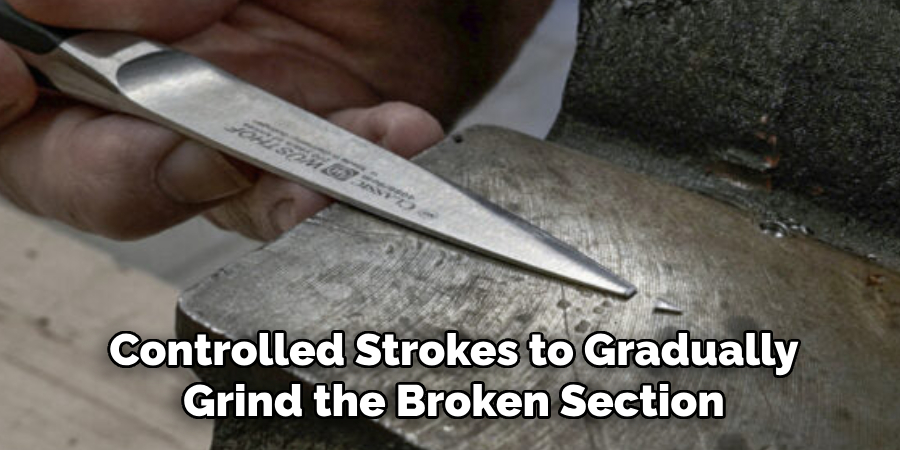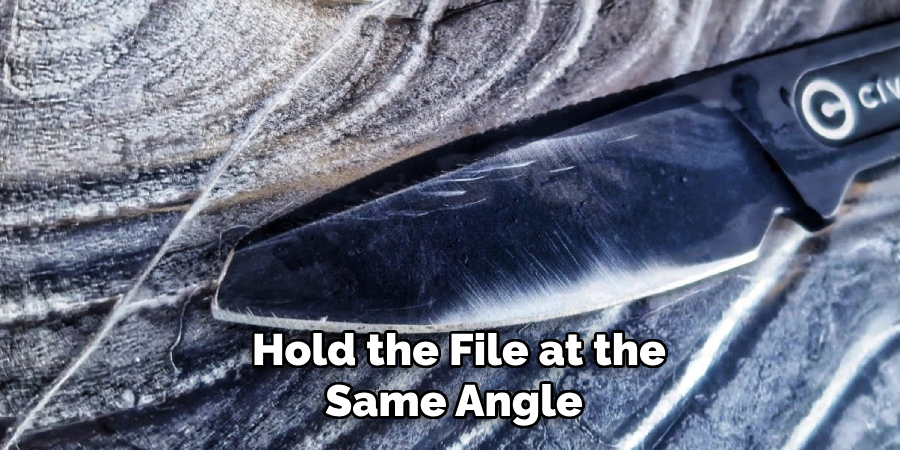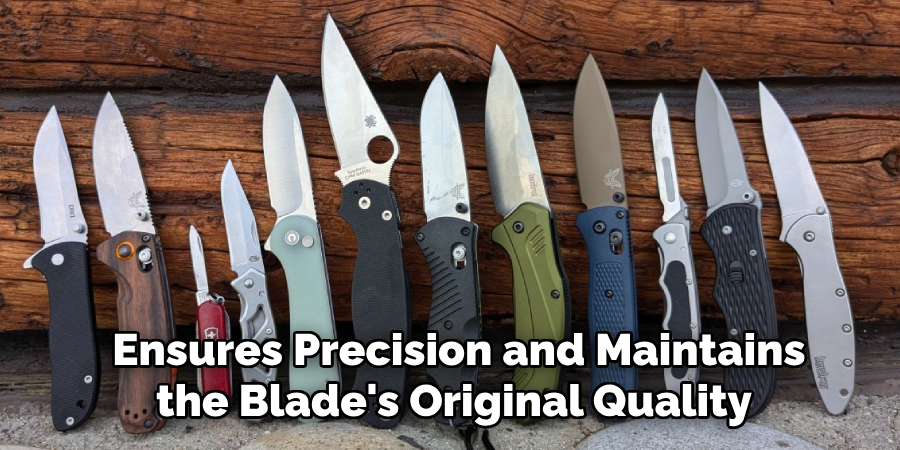A broken knife tip can render even the finest blade less effective, compromising its ability to perform precise cuts. Several factors can lead to this issue, with improper use and accidental drops being the most common culprits. For instance, using a knife for tasks beyond its intended purpose, such as prying, can exert excessive force on the tip, causing it to break. Similarly, dropping a knife on a hard surface can result in a fractured tip. Restoring a broken knife tip is essential to regain the knife’s full functionality and ensure safety and efficiency in the kitchen or outdoors.

This article will explore how to fix a broken knife tip, offering a step-by-step guide to repairing the damage or determining when it may be more prudent to replace the blade entirely. With this knowledge, knife enthusiasts can extend their tools’ lifespan and maintain peak performance.
Understanding the Types of Knife Tips
Pointed Knife Tips
Pointed knife tips are common on various types of knives, such as paring knives, utility knives, and chef’s knives. These tips are characterized by their sharp, tapered ends, which enable precise cutting tasks. The sharpness and angle of a pointed tip play critical roles in determining the knife’s cutting abilities. A more acute angle provides finer precision and cleaner penetration, which is ideal for detailed tasks like slicing vegetables or removing seeds. However, this sharpness requires regular maintenance to retain its effectiveness. The pointed tip design optimizes control and accuracy, making it versatile in many kitchen settings.
Drop Point and Clip Point Tips
Drop-point and clip-point tips offer distinct functionalities compared to pointed tips and are often found on hunting and utility knives. A drop point tip features a convex curve on the spine, allowing for better control and strength, which is beneficial in applications needing durability, such as skinning games or general utility tasks. In contrast, a clip point tip shows a concave curve, creating a sharper, more controllable point perfect for piercing. Both types differ from pointed tips by offering enhanced robustness and versatility, making them suitable for more demanding cutting tasks where precision is coupled with strength.
Common Causes of a Broken Knife Tip
Impact Damage
Impact damage is a prevalent cause of broken knife tips, primarily from accidental drops or collisions with hard surfaces. When a knife falls onto a tiled or concrete floor, the impact can be severe enough to chip or snap off the delicate tip entirely. Additionally, hitting hard materials like bones or ice can similarly compromise the knife’s structural integrity. Poor storage habits also contribute significantly to tip damage; when knives are tossed into drawers without protection, they can collide with other utensils, leading to nicks and chips. To prevent such damage, it’s essential to store knives in dedicated blocks, magnetic strips, or protective sheaths and handle them with care during use.

Misuse of the Knife
Misusing a knife for purposes beyond its intended design is another common factor leading to broken tips. Activities such as prying open cans or using the tip to screw or lever objects exert undue pressure, which the delicate design of a knife tip is not equipped to endure. Such misuse often results in bending, chipping, or breaking the tip entirely. To preserve the integrity of a knife, it’s crucial to adhere to its correct usage guidelines; this includes using the right knife for each task and ensuring regular maintenance like sharpening and cleaning. Following these practices not only extends the life of a knife but also enhances safety and cutting efficiency.
Assessing the Damage
Inspecting the Broken Tip
Inspecting the knife tip is the first step in assessing the extent of the damage. Begin by closely examining the tip under a good light source, looking for any cracks, chips, or entirely missing sections. Use a magnifying glass if necessary to detect fine fractures that might not be immediately visible to the naked eye. The goal is to identify whether the damage is limited to minor chipping or if there is a more substantial break. Understanding the severity of the damage will guide the decision-making process on whether repair is possible or if the knife needs replacement. This careful inspection ensures that any repair attempts are based on a comprehensive understanding of the knife’s condition.
Checking the Blade for Other Issues
Apart from the tip, it is crucial to inspect the entire blade for additional issues, such as bends, nicks, or fractures, that may affect the knife’s performance. Run your fingers gently along the blade’s edge to feel for any irregularities, paying special attention to any sections that appear bent or have surface discoloration indicative of stress. Any noticeable defects can compromise the knife’s overall integrity and safety in use. Determining whether the damage is confined to the tip or involves the entire blade is critical in deciding the need for comprehensive repairs or the potential necessity of replacing the knife altogether. Regular assessments can also serve as a preventive measure, addressing minor issues before they escalate.
Tools Needed to Fix a Broken Knife Tip
Sharpening Stones
Sharpening stones are essential tools for grinding down and reshaping a broken knife tip. To begin the repair, place the knife at an angle on the stone and use steady, controlled strokes to gradually grind the broken section. It’s important to start with a coarser grit stone to reshape the tip and then progress to finer grits to smooth out and refine the newly formed tip. This progression helps achieve a sharp and polished finish, restoring the knife’s utility and precision.

Diamond Files
Diamond files are invaluable for precisely reshaping a knife tip and grinding away rough edges. Their abrasive surfaces can easily handle the hard steel of most knife blades. A fine-grit diamond file is particularly advantageous for smaller or more delicate repairs, allowing for careful control and precision. These files provide a smooth finish and help maintain the knife’s original sharpness and profile after reshaping, making them an ideal choice for meticulous repairs.
How to Fix a Broken Knife Tip: Step-by-Step Guide
Reshaping the Tip with a Sharpening Stone
To begin repairing a broken knife tip, secure a sharpening stone on a stable surface. Hold the knife at a consistent angle, typically around 20 degrees, ensuring you have a firm grip on the handle to maintain control throughout the process. Gently place the broken tip against the coarser grit of the stone, and use smooth, consistent strokes away from your body to grind down the damaged area. It’s crucial to apply gentle pressure and move the knife in a single, controlled direction to avoid uneven wear.
Commit to patient work, regularly re-evaluating the angle and progress to ensure a uniform shape. Take your time—any rush can cause further damage or create an uneven edge. Once the general shape is restored, switch to a finer grit to refine the edge, repeating the steady stroking motion to enhance the sharpness and precision of the new tip.
Using a Diamond File for Fine Adjustments
After reshaping with the sharpening stone, use a diamond file for meticulous adjustments to the newly formed tip. Hold the file at the same angle as before and gently stroke it along the tip’s edges to remove any rough spots. Focus on ensuring that the tip is sharp, paying particular attention to its alignment with the rest of the blade. The file’s abrasive particles should be used in a controlled manner to refine the edge without compromising the shape. Precision is key here to maintain uniformity and sharpness, preventing any jagged edges that could affect the knife’s performance.

Polishing the Tip for Smoothness
Complete the repair by polishing the tip using a finer grit stone or a compound. This step restores the knife’s smooth and sharp finish, contributing to its overall functionality and appearance. Hold the knife at the same angle used during the previous steps and apply the polishing compound. Use deliberate, gentle strokes to eliminate any remaining burrs or imperfections, ensuring the tip seamlessly aligns with the blade’s edge. This final polish enhances the sharpness and returns the tip to its original sleek and uniform look, free from visible flaws. Regular maintenance and careful handling are recommended post-repair to sustain the knife’s peak condition.
When to Replace the Knife Tip
Signs That Repair Is Not Feasible
In certain situations, replacing the knife tip is the more practical decision. If the damage is extensive, with large or deep breaks that compromise the blade’s structural integrity, repair may not be viable. Additionally, consider the costs and time involved in attempting repairs. If these outweigh the price of a new knife, rea lacement can be the more economical and efficient choice. Ensure to evaluate the extent of damage before deciding on repair or replacement.
Considerations for Professional Repair
In cases where the knife holds significant value or sentimental importance, seeking professional repair might be the optimal solution. Specialists or manufacturers can expertly restore the tip, enhancing both its functionality and aesthetic appeal. Professional repair ensures precision and maintains the blade’s original quality, which is particularly beneficial for high-end or custom knives. This approach often results in a longer-lasting repair that preserves the knife’s inherent qualities.

Conclusion
In conclusion, the process of how to fix a broken knife tip involves carefully reshaping the tip using sharpening stones and diamond files, followed by a meticulous polish to ensure smoothness and sharpness. However, there are instances where replacement is more practical, such as when the damage is too extensive. Regular inspection and maintenance are crucial to prevent future damage and prolong your knives’ lifespan. Keeping your knives sharp and well-maintained will ensure their optimal performance over time. Regular upkeep preserves their functionality and enhances safety and efficiency in use.
Edmund Sumlin is a skilled author for Metal Fixes, bringing 6 years of expertise in crafting a wide range of metal fixtures. With a strong background in metalwork, Edmund’s knowledge spans various types of fixtures, from decorative pieces to functional hardware, blending precision with creativity. His passion for metalworking and design has made him a trusted resource in the industry.
Professional Focus:
- Expert in Metal Fixtures : Edmund aesthetic specializes in creating durable and innovative metal fixtures, offering both appeal and functionality. His work reflects a deep understanding of metalworking techniques and materials.
- Sustainability Advocate : He is dedicated to using sustainable practices, ensuring that every fixture is crafted with eco-friendly methods while maintaining high-quality standards.
In his writing for Metal Fixes, Edmund provides valuable insights into the latest trends, techniques, and practical advice for those passionate about metal fixtures, whether they are professionals or DIY enthusiasts. His focus on combining artistry with engineering helps others discover the true potential of metal in design.


